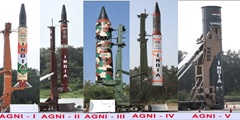13 October, 2025
Agni-5 Intermediate Range Ballistic Missile Successful Test
Fri 22 Aug, 2025
Reference:
- India successfully tested its most advanced intercontinental ballistic missile (ICBM) Agni-5 from the Integrated Test Range (ITR), Chandipur, Odisha.
Key Points:
- Test: Conducted under the supervision of Strategic Forces Command by the Ministry of Defence and Defence Research & Development Organisation (DRDO).
- The missile met all operational and technical parameters, significantly enhancing India’s strategic capabilities.
Strike Capability and Range:
- Strike Range: Over 5,000 km, placing it in the Intercontinental Ballistic Missile (ICBM) category.
- Covers the whole of Asia, northern regions of China, parts of Europe, and some regions of Africa.
MIRV Technology:
- Agni-5 employs Multiple Independently Targetable Re-entry Vehicle (MIRV) technology.
- This enables a single missile to strike multiple targets with different warheads simultaneously.
- MIRV was first developed by the US in 1970, and India now joins a select group of countries (USA, Russia, China, France, UK) possessing this technology.
- Provides India the capability to target multiple locations, including command centers, weapon depots, or bunkers, in a single launch.
Propulsion and Speed:
- Three-stage solid-fuel propulsion system enables rapid launch and high reliability.
- Speed: Mach 24 (~8.16 km/sec), allowing near-instant target reach.
Canister Launch System:
- Canister-based launch allows easy transportation by road or rail and launch from any location.
- Enhances deployment flexibility and stealth.
Navigation and Accuracy:
- Advanced navigation and guidance system, including ring laser gyroscope and GPS/INS (Inertial Navigation System), ensures precise targeting.
- Radar, telemetry stations, and sea-based ships collected real-time data during the test to validate accuracy.
Payload Capacity:
- Agni-5 can carry up to 1.5 tons, including nuclear and conventional warheads.
- DRDO is developing a non-nuclear variant for the Air Force.
- Can carry heavy warheads (~8 tons) capable of airburst or destroying runways and radar systems.
Strategic Importance:
- Minimum Credible Deterrence: Supports India’s ‘No First Use’ policy, ensuring nuclear weapons are used solely for self-defense.
- Regional Power Balance: Covers Pakistan, China, and neighboring countries (Bangladesh, Sri Lanka, Maldives, Nepal, Bhutan).
- Specifically targets northern Chinese cities (Beijing, Shanghai, Hong Kong) and military installations in Tibet.
- Pakistan has expressed concerns; Strategic Vision Institute (SVR), Islamabad, called it a “warning bell” for Pakistan.
- Strengthens India’s regional strategic position, especially against China’s DF-21 missiles deployed from Tibet.
Global Status:
- With Agni-5’s successful test, India joins six countries (USA, Russia, China, France, UK, India) with ICBM capabilities.
- Enhances India’s strategic autonomy and global power balance role.
Bunker-Buster Capability:
- Agni-5 can be upgraded in the future with bunker-buster capability to destroy deep bunkers and command centers.
- Critical for underground installations along Pakistan and China’s borders.
Future Prospects:
- Range Expansion: DRDO plans to extend Agni-5’s range to 8,000 km, potentially targeting the USA and other continents.
- Non-Nuclear Air Force Variant: DRDO developing a non-nuclear version to target runways, radar, and other military installations.
Intercontinental Ballistic Missile (ICBM):
- Long-range ballistic missile capable of delivering nuclear or conventional warheads beyond 5,500 km.
Features:
- Range: Minimum 5,500 km, capable of targeting across continents. Modern ICBMs can reach 10,000–15,000 km.
- Propulsion: Solid or liquid-fuel systems. Solid fuel offers reliability and quick launch.
- Payload: Single or MIRV-enabled multiple warheads.
- Speed: Mach 20–25 (~24,000–30,000 km/h), difficult to intercept.
- Navigation: Advanced INS, GPS, and ring laser gyroscope for precise targeting.
- Launch Platforms: Silo, mobile launcher (truck/rail), or submarine.
Operation:
- Launch Stage → Boost Stage → Mid-Flight Stage → Re-entry Stage → Terminal Stage for accurate strike.
Strategic Significance:
- Deterrence: Basis of credible minimum deterrence.
- Power Balance: Important for regional and global strategic stability.
- MIRV Capability: Challenges missile defense systems.
- Strategic Flexibility: Mobile/canister launch enables rapid and covert deployment.
Countries with ICBM Capability:
- USA: Minuteman III, Trident II (submarine-based)
- Russia: RS-28 Sarmat, Topol-M
- China: DF-41, DF-31
- India: Agni-5 (5,000+ km range, MIRV-enabled)
- France: M51 (submarine-based)
- North Korea: Hwasong-15 (experimental)
- UK: Trident II (in cooperation with USA)
Agni Missile Family
- Developed by DRDO; name ‘Agni’ means ‘fire’ in Sanskrit.
- Core of India’s strategic and nuclear deterrence.
Key Variants:
- Agni-I: SRBM, 700–1,200 km, payload ~1,000 kg, solid fuel, operational
- Agni-II: MRBM, 2,000–3,000 km, payload ~1,000 kg, solid fuel, operational
- Agni-III: IRBM, 3,000–5,000 km, payload ~1,500 kg, two-stage solid fuel, operational
- Agni-IV: IRBM, 3,500–4,000 km, payload 800–1,000 kg, advanced navigation, MIRV potential
- Agni-V: ICBM, 5,000–5,500 km (future 7,500–8,000 km), payload ~1,500 kg, MIRV-enabled, canister-based, tested 20 Aug 2025
- Agni-VI: ICBM, projected 8,000–12,000 km, MIRV, non-nuclear option, under development
- Agni-P: Advanced, 1,000–2,000 km, MIRV-enabled, test phase
Development & Testing:
- Agni-I development began in 1989, operational in 1990s.
- Recent Agni-V test on 20 Aug 2025 at Chandipur, Odisha, demonstrated MIRV and advanced technologies.
- Regular tests at Integrated Test Range (ITR), Chandipur, and Abdul Kalam Island.
Intermediate Range Ballistic Missile (IRBM):
- Range: 3,000–5,500 km, capable of nuclear or conventional warheads.
- Propulsion: Solid/liquid fuel.
- Payload: 500–2,000 kg, nuclear (10–200 kt) or conventional, some with MIRV.
- Speed: Mach 10–20 (~12,000–24,000 km/h).
- Navigation: INS, ring laser gyroscope, GPS.
- Launch Platforms: Silo, mobile launcher, canister.
Operation:
- Launch → Boost → Mid-flight → Re-entry → Terminal for precise strike
IRBM Examples by Country:
- India: Agni-III (3,000–5,000 km), Agni-IV (3,500–4,000 km)
- China: DF-21 (3,000–4,000 km), DF-26 (3,000–5,000 km, MIRV-enabled)
- Russia: RS-26 Rubezh (5,800 km, IRBM/ICBM border)
- North Korea: Hwasong-12 (3,700–4,500 km)
- Israel (estimated): Jericho II (3,500 km, solid fuel, nuclear-capable)


















